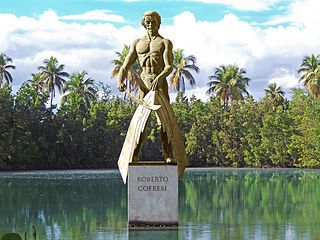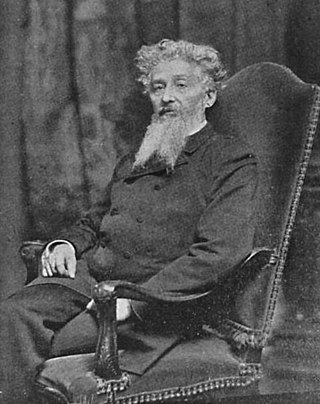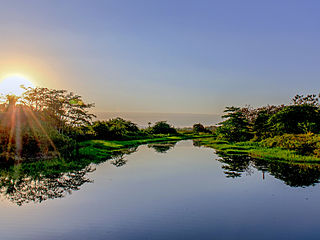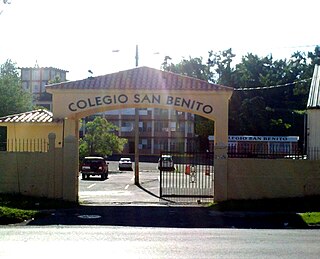
Roberto Cofresí y Ramírez de Arellano, better known as El Pirata Cofresí, was a pirate from Puerto Rico. He was born into a noble family, but the political and economic difficulties faced by the island as a colony of the Spanish Empire during the Latin American wars of independence meant that his household was poor. Cofresí worked at sea from an early age which familiarized him with the region's geography, but it provided only a modest salary, and he eventually decided to abandon the sailor's life and became a pirate. He had previous links to land-based criminal activities, but the reason for Cofresí's change of vocation is unknown; historians speculate that he may have worked as a privateer aboard El Scipión, a ship owned by one of his cousins.

Cabo Rojo is a city and municipality situated on the southwest coast of Puerto Rico and forms part of the San Germán–Cabo Rojo metropolitan area as well as the larger Mayagüez–San Germán–Cabo Rojo Combined Statistical Area.

Ramón Emeterio Betances y Alacán was a Puerto Rican independence advocate and medical doctor. He was the primary instigator of the Grito de Lares revolution and is considered to be the father of the Puerto Rican independence movement. Since the Grito galvanized a burgeoning nationalist movement among Puerto Ricans, Betances is also considered "El Padre de la Patria". Because of his charitable deeds for people in need, he also became known as "El Padre de los Pobres".

Segundo Ruiz Belvis was a Puerto Rican abolitionist who also fought for Puerto Rico's right to independence.

El Grito de Lares, also referred to as the Lares uprising, the Lares revolt, the Lares rebellion, or the Lares revolution, was the first major revolt against Spanish rule in Puerto Rico. The revolt was planned by Ramón Emeterio Betances and Segundo Ruiz Belvis. It began on September 23, 1868 in the town of Lares, for which it is named. It spread rapidly to various revolutionary cells throughout the island.
Mathias Brugman, a.k.a. Mathias Bruckman, was a leader in Puerto Rico's independence revolution against Spain known as El Grito de Lares .

The Roman Catholic Diocese of Mayagüez is an ecclesiastical territory or diocese of the Roman Catholic Church in the United States and consists of the western part of the island of Puerto Rico, an American commonwealth. The diocese is led by a prelate bishop, who pastors the motherchurch in the City of Mayagüez, Catedral Nuestra Señora de la Candelaria in front of the Plaza Colón.
Dr. Pedro Valle Carlo, is a retired college professor and noted environmentalist leader based in western Puerto Rico.
The city of Mayagüez, in Western Puerto Rico, was founded by Spanish colonists in 1760. The area had long been settled by indigenous Taínos. Mayagüez became self-governing in 1763 and was made a villa in 1836. Severe fire damage in 1841 compelled extensive rebuilding. The town became the focus of a distinctive regional identity and was home to liberal and radical thinkers such as Eugenio María de Hostos and the pro-independence activist Ramón Emeterio Betances. City charter status was granted in 1877.

Calle Méndez Vigo is a major thoroughfare in the western Puerto Rico municipality of Mayagüez with a length of about 1.22 miles. The street is oriented east–west with traffic running one-way westbound with the number of lanes going from one to two after the road passes Calle Ramón Emeterio Betances in downtown Mayagüez. Some of the most important historical places in Mayagüez are located on this street:

The Mayagüez Metropolitan Statistical Area is a United States Census Bureau defined Metropolitan Statistical Area (MSA) in west central Puerto Rico. A July 1, 2009 Census Bureau estimate placed the population at 109,842, a 4.53% decrease from the 2000 census figure of 115,048.

Isla de Ratones also known as Cayo Ratones or Isla Ratones is a small island located near the Joyuda Lagoon in Cabo Rojo, Puerto Rico. The island is a popular spot for snorkeling and bathing.

The Guanajibo River is a river that runs through Hormigueros, Cabo Rojo, Mayagüez, San Germán, and Sabana Grande in Puerto Rico.
The Hondo River is a river of Hormigueros, Puerto Rico. It runs through the municipalities of Hormigueros, Mayagüez, and Cabo Rojo.
Relin Sosa Athletic Track is an athletic track in Cabo Rojo, Puerto Rico. It hosted some of the football events for the 2010 Central American and Caribbean Games.

The Catedral Nuestra Señora de la Candelaria or in English, Our Lady of the Candelaria Cathedral, is the cathedral for the Roman Catholic Diocese of Mayagüez located in the eastern end of the Colón Main Square facing the town hall in Mayagüez, Puerto Rico.

Calle Ramón Emeterio Betances is the longest urban road in Mayagüez, serving as the Main Street of Mayagüez. It corresponds with the former Post Street's south of Yagüez River section.

Colegio San Benito ("CSB") is a private Roman Catholic, university-preparatory and elementary school, founded in Mayagüez, Puerto Rico in 1965. The school was the first boys-only Catholic school founded in the area of Mayagüez.
The Pontifical Catholic University of Puerto Rico at Mayagüez is a private, Roman Catholic university in Mayagüez, Puerto Rico. It is part of the Pontifical Catholic University of Puerto Rico.

Cabo Rojo barrio-pueblo is a barrio and the administrative center (seat) of Cabo Rojo, a municipality of Puerto Rico. Its population in 2010 was 1,078.














